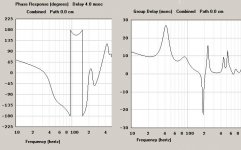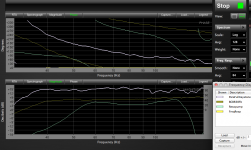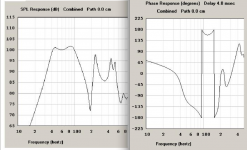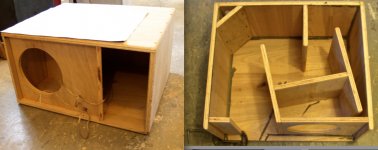I'm not sure how the outer chamber would affect the tuning of the inner chambers though.
It will affect their tuning. The output port is basically in series with the inner ones.
The first image looks like a design that I was considering a few years ago, except that the shelf vents at the top and bottom were actually vents for the front volume, and the rear volume was vented directly into the front volume. It looked good on paper, particularly as the arrangement allowed for a design where the driver could be accessed by removing a rear panel.
Well originally I wanted the driver to be front mounted, because often the gaskets around the back of woofers are superior to ones on the front, and it also allows the woofer to fall into place when the cab is on its back, but that latest port design allows for two side access panels behind the driver, and also room for a bracing grid like in the dB designs (although the dB designs are front mount and the front chamber has just a square hole without any port length!)
what exactly does this port compression do what all guys here are talking about?
To double the amplitude pressure (+6dB) of a sound wave produced by one speaker, excursion and port velocity will generally double. This will normally require about 4 x the power as you need to increase the stored energy in the air by 4 and the kinetic energy of the speaker cone by 4 because the velocity has doubled, but the frequency is the same.
Moving air however, needs up to 8 x the power to overcome air resistance for every doubling of velocity (air resistance is proportional to speed squared, and power you multiply by speed again). When port speeds get too high, this becomes the dominating factor in power consumption, and eventually you'd need 8 x the power for +6dB through the ports!
On top of that you'd get an audible chuffing/hissing sound if the port is too restricted.
Hi Tim Lewis,
I like your enclosure design from Post #5.
18 Sound has a similar bandpass for a 21" that uses a single duct from the back to the front. That one may be a easier to build, on the other hand, your design reinforces the side panels very well. I have no clear idea if one large port radiates better than 4 equivalent smaller ports, maybe somebody can shine some light on this.
http://www.eighteensound.com/Portals/0/EnclosuresKits/18sound_single_21 kit.pdf
If you are going for a shaped port (Art's example in Post #6, Polk's Power Port or JBL's Jet Port) a single port would be easier. Ideally the shaped ports seem to have as their rationale an improved transition from duct to box and duct to outside.
Regards,
I like your enclosure design from Post #5.
18 Sound has a similar bandpass for a 21" that uses a single duct from the back to the front. That one may be a easier to build, on the other hand, your design reinforces the side panels very well. I have no clear idea if one large port radiates better than 4 equivalent smaller ports, maybe somebody can shine some light on this.
http://www.eighteensound.com/Portals/0/EnclosuresKits/18sound_single_21 kit.pdf
If you are going for a shaped port (Art's example in Post #6, Polk's Power Port or JBL's Jet Port) a single port would be easier. Ideally the shaped ports seem to have as their rationale an improved transition from duct to box and duct to outside.
Regards,
I quite like the 18Sound enclosure. Cutting circles in a front access panel for stock flared ports could be quite a good idea.
It looks to go lower than mine, it appears to be tuned around 30Hz but mine appears to be louder above 40Hz, real world test pending. Whilst it is possible if you spend some time calculating angles, it could be difficult to flare triangular corner ports, hence the design in post 18 with two flared slot ports for the ~40Hz chamber and 1 for the ~80Hz chamber, and I still should be able to cut ply thickness down between 9 and 12mm.
Braced flexiply and it's almost a W-Bin!
It looks to go lower than mine, it appears to be tuned around 30Hz but mine appears to be louder above 40Hz, real world test pending. Whilst it is possible if you spend some time calculating angles, it could be difficult to flare triangular corner ports, hence the design in post 18 with two flared slot ports for the ~40Hz chamber and 1 for the ~80Hz chamber, and I still should be able to cut ply thickness down between 9 and 12mm.
Braced flexiply and it's almost a W-Bin!
Last edited:
Hi Tim Lewis,
Post #25: "...and it's almost a W-Bin!"
In another thread http://www.diyaudio.com/forums/subwoofers/263921-most-powerful-21-woofer-9.html the Fohhn PS-9 subwoofer has been mentioned. To me it looks like a BP6, and it looks a bit like your description:
http://www.fohhn.com/uploads/media/Broschuere_PS-9_Sub_engl.pdf
In that same thread, Post #90 papasteack suggested a OD-QWP that reminded me of the OD-TTL which can have a much bigger line terminus. So you get the direct radiator output and the line output from a large mouth. I'll attach an example w/ the 18SW115 (disregard the 1000W in the Hornresp Input comment line, see: Eg):
Regards,
Post #25: "...and it's almost a W-Bin!"
In another thread http://www.diyaudio.com/forums/subwoofers/263921-most-powerful-21-woofer-9.html the Fohhn PS-9 subwoofer has been mentioned. To me it looks like a BP6, and it looks a bit like your description:
http://www.fohhn.com/uploads/media/Broschuere_PS-9_Sub_engl.pdf
In that same thread, Post #90 papasteack suggested a OD-QWP that reminded me of the OD-TTL which can have a much bigger line terminus. So you get the direct radiator output and the line output from a large mouth. I'll attach an example w/ the 18SW115 (disregard the 1000W in the Hornresp Input comment line, see: Eg):
Regards,
Attachments
-
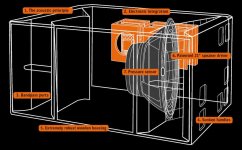 Fohhn PS9.jpg46.9 KB · Views: 302
Fohhn PS9.jpg46.9 KB · Views: 302 -
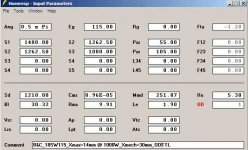 18SW115_ODTTL_Input.jpg26.3 KB · Views: 318
18SW115_ODTTL_Input.jpg26.3 KB · Views: 318 -
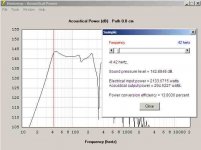 18SW115_ODTTL_max electrical input power_no filter.jpg22.9 KB · Views: 299
18SW115_ODTTL_max electrical input power_no filter.jpg22.9 KB · Views: 299 -
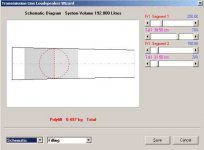 18SW115_ODTTL_Wizard_Schematic.jpg16.5 KB · Views: 293
18SW115_ODTTL_Wizard_Schematic.jpg16.5 KB · Views: 293 -
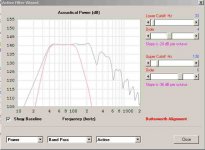 18SW115_ODTTL_Wizard_SPL.jpg20.4 KB · Views: 291
18SW115_ODTTL_Wizard_SPL.jpg20.4 KB · Views: 291 -
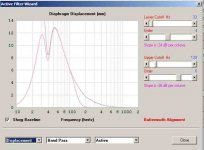 18SW115_ODTTL_Wizard_Displacement.jpg19.1 KB · Views: 117
18SW115_ODTTL_Wizard_Displacement.jpg19.1 KB · Views: 117
Last edited:
Comparisons of impedance and SPL between my design and the Eighteen Sound 21".
Also impulse data and excursion at 2.83V
Also impulse data and excursion at 2.83V
Attachments
Last edited:
Measured with an SPL meter with "impulse response", rather than the usual "fast" or "slow" response found on most meters, a Keystone Sub loaded with a BC18SW115, in half space, can exceed 140 dB SPL peaks in the upper range, around 90 Hz. It probably could come close at the Fb/Fc of 35 Hz also. Driven below Fb it can easily blow out a candle at several feet distant (I have seen "rooster tails" of sawdust fly across the shop at certain test frequencies), but blowing air is a sign of unloading or turbulence.Although the keystone measured at 132dB in your link (half space) so I wouldn't expect this to be as loud. I'd imagine under continuous sine waves there would be heating but do you think momentarily it could reach these levels, or at least break the 140 mark, corner loaded?
My 2 12" were predicted to do 135dB 1m both in the same corner. I have built these and they can violently flicker a lighter flame from several feet out into the room and that's just 3012lf drivers in bass reflex.
I have built subs of pretty much every type:BR (bass reflex),FLH (front loaded horn)DFLH (FLH with duct leading from near throat to later horn expansion point), FLH/BR (FLH with BR ports) TH (tapped horn) ISOTQWP (isobaric tuned quarter wave pipe) PPSLBR (push pull slot loaded BR) and a few different BP (band pass) designs.
Having done a fair amount of listening to subs with and without top cabinets, I found it interesting that with frequency response equalized flat through the pass band, the BP subs still sounded "muddy" and ill defined compared to all the others.
Although the BP designs have an excellent volume to SPL ratio and high sensitivity, the rapid phase shift that accompanies the rapid upper frequency drop off also makes it impossible (using non-FIR filter topology) to get a smooth phase alignment with upper cabinets through the acoustic crossover region. Lack of a smooth phase response in the 80-100 Hz region (the upper pass band point of the designs I built) results in a lack of "punch" or "impact" in that range, kick drum sounds flabby, an upright bass lacks articulation and definition.
That said, if one primarily listens to music with droning kick and bass lines, lack of articulation and definition won't make a difference ;^).
Art
Last edited:
Critique.
I'm assuming the graph at 90Hz is a "wrap around" the scale and not a swift motion through 360 degrees, otherwise the group delay chart would spike right?
True it does move over the passband from -45 to -180 and I don't think this cabinet would sound as tight as a stack of front loaded horns outside.
I've found in some of my travels that the room is more responsible for the so called "slow bass" than the enclosure, with many kicks being blurred together by room resonances. My flat (and car probably) happen to be a lot better for tight sound than my parents' living room for instance.
The impulse chart does show a bit of resonance at 40Hz, and if the tops are lined up with the subs, you'd probably need to reverse polarity on this subwoofer to get the crossover in phase.
I'm assuming the graph at 90Hz is a "wrap around" the scale and not a swift motion through 360 degrees, otherwise the group delay chart would spike right?
True it does move over the passband from -45 to -180 and I don't think this cabinet would sound as tight as a stack of front loaded horns outside.
I've found in some of my travels that the room is more responsible for the so called "slow bass" than the enclosure, with many kicks being blurred together by room resonances. My flat (and car probably) happen to be a lot better for tight sound than my parents' living room for instance.
The impulse chart does show a bit of resonance at 40Hz, and if the tops are lined up with the subs, you'd probably need to reverse polarity on this subwoofer to get the crossover in phase.
Attachments
Last edited:
I'm assuming the graph at 90Hz is a "wrap around" the scale and not a swift motion through 360 degrees, otherwise the group delay chart would spike right?
Correct on both counts.
You might find that altering the default-calculated offset delay correction from 4.0 msec to something different, will remove the 90 Hz phase wrap.
Well in that case it seems to have a smooth phase response from -60 to -180 in a corner and -45 to -180 not in a corner in the pass band I'm concerned with.
It may or may not require a reverse in polarity depending on where the top speakers are.
It may or may not require a reverse in polarity depending on where the top speakers are.
Tim,Well in that case it seems to have a smooth phase response from -60 to -180 in a corner and -45 to -180 not in a corner in the pass band I'm concerned with.
A "smooth" phase response is relative.
Let's look at four examples of phase and frequency response from 40-100Hz.
In the black background is the measured response of three subs:
White trace: B&C18SW115-4 loaded tapped horn, 38 degree phase wrap.
Yellow trace:B&C18SW115-4 loaded bass reflex(AKA "phase inversion"), 176 degree phase wrap.
Green trace: Eminence HL10C (basically a Lab 10") loaded "Resopump" band pass sub, 216 degree phase wrap. I built the Resopump based on a simulation Phillip Graham came up with, and provided the nickname. It took quite a bit of head scratching for me to figure out how to turn the crosssectional areas of the sim into reality, but the measured results were very close, a very efficient little sub. I had planned to build several small subs for DJ rental, so was comparing several "bite size" options, the Resopump had really good bang for the buck, SPL similar to a 15" in a larger cabinet. From the front it looks just like a BR cabinet with a very large port, so there is no questions raised or prejudices ("backwards" speakers can't sound good, why are those speakers pointed at each other ? etc.) raised.
Your BP sub simulation appears to have about 190 degrees of phase wrap, frequency and phase response similar to the Resopump, just shifted downward in frequency.
The TH or BR sound fine crossed at 100 Hz, either can actually be crossed quite a bit higher and still sound OK.
The Resopump, although having a smooth response in it's pass band (+/- 3dB from 54 to 128 Hz), just did not sound "real" compared to a BR cabinet loaded with a similar driver. I did a lot of listening comparisons between it and other subs, equalizing their response and level the same, listening with and without top cabinets (phase aligned at crossover) over a few days. The bottom line is the Resopump, like every BP cabinet I have heard thus far, just sounded muddy by comparison to other sub designs. I found that even when it was set at a louder SPL than another BR or sealed sub, my ear would be drawn to the other sub.
At any rate, the BP sub did not sound "bad", like many floppy "one note wonders", but it just did not sound good by comparison with a decent sounding sub.
I eventually sold the HL10C driver, and re used the cabinet with a different design using a pair of Lab 12s.
Art
Attachments
Last edited:
If that's a picture of the "Resopump", then how is it a BP alignment? Where's the front chamber? Its cross-section looks more like a RLH than a BP design...
I was thinking that it was more like a mini scoop cabinet with a slight block of the mouth.
As my design does not have an exposed driver, wouldn't it filter harmonic distortion much like a front loaded horn does? Thus it wouldn't sound too muddy, although it does have a slight 40Hz resonance in the impulse response.
If it sounds as good or better than my bass reflex Kappalite 3012LF cabs I won't be too dissapointed if it doesn't have the "punch" of a group of front loaded horn cabs outdoors.
As my design does not have an exposed driver, wouldn't it filter harmonic distortion much like a front loaded horn does? Thus it wouldn't sound too muddy, although it does have a slight 40Hz resonance in the impulse response.
If it sounds as good or better than my bass reflex Kappalite 3012LF cabs I won't be too dissapointed if it doesn't have the "punch" of a group of front loaded horn cabs outdoors.
- Status
- Not open for further replies.
- Home
- Loudspeakers
- Subwoofers
- Maximum Port Velocity



